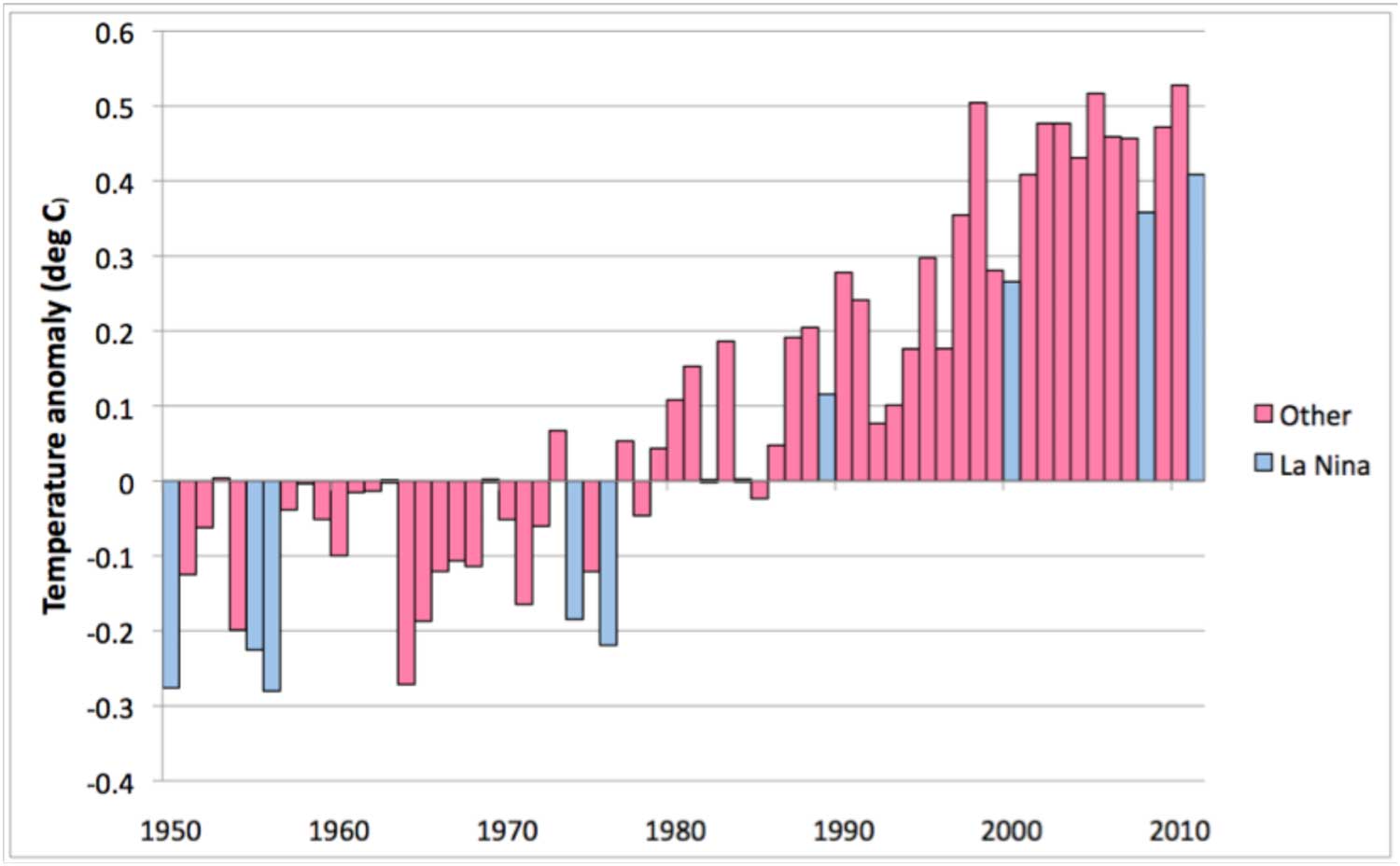
The following is a reprint of a news release isssued by the World Meteorological Organization (WMO) on Nov 29, 2011, with a few minor additions by Skeptical Science.
Global temperatures in 2011 are currently the tenth highest on record and are higher than any previous year with a La Niña event, which has a relative cooling influence (Figure 1). The 13 warmest years have all occurred in the 15 years since 1997. The extent of Arctic sea ice in 2011 was the second lowest on record, and its volume was the lowest (Figure 2).
Figure 1: Average of NOAA, GISS, and HadCRUT annual global surface temperature anomalies. Blue bars indicate years influenced by La Niña events. 2011 is the warmest La Niña-influenced year on record (Source: WMO)
Figure 2: Arctic sea ice volume from PIOMAS, added to the press release by Skeptical Science
These are some of the highlights of the provisional annual World Meteorological Organization Statement on the Status of the Global Climate, which gives a global temperature assessment and a snapshot of weather and climate events around the world in 2011. It was released today at the international climate conference in Durban, South Africa.
“Our role is to provide the scientific knowledge to inform action by decision makers,” said WMO Secretary-General Michel Jarraud. “Our science is solid and it proves unequivocally that the world is warming and that this warming is due to human activities,” he said.
“Concentrations of greenhouse gases in the atmosphere have reached new highs. They are very rapidly approaching levels consistent with a 2-2.4 degree Centigrade rise in average global temperatures which scientists believe could trigger far reaching and irreversible changes in our Earth, biosphere and oceans,” he said.
The WMO’s provisional statement estimated the global combined sea surface and land surface air temperature for 2011 (January–October) at 0.41°C ± 0.11°C (0.74°F ± 0.20°F) above the 1961–1990 annual average of 14.00°C/57.2°F, according to the provisional statement. This is the tenth equal warmest year since the start of records in 1850.
The 2002-2011 period equals 2001-2010 as the warmest decade on record, 0.46°C above the long-term average.
Global climate in 2011 was heavily influenced by the strong La Niña event which developed in the tropical Pacific in the second half of 2010 and continued until May 2011. It was one of the strongest of the last 60 years and was closely associated with the drought in east Africa, islands in the central equatorial Pacific and the southern United States, and flooding in southern Africa, eastern Australia and southern Asia.
Strong La Niña years are typically 0.10 to 0.15°C cooler than the years preceding and following them. 2011’s global temperatures followed this pattern, being lower than those of 2010, but were still considerably warmer than the most recent moderate to strong La Niña years, 2008 (+0.36°C), 2000 (+0.27°C) and 1989 (+0.12°C). Weak La Niña conditions have redeveloped in recent weeks but have not yet approached the intensity of those in late 2010 and early 2011.
Surface air temperatures were above the long-term average in 2011 over most land areas of the world. The largest departures from average were over Russia, especially in northern Russia where January-October temperatures were about 4°C above average in places.
The seasonal Arctic sea ice minimum, reached on 9 September, was 4.33 million square kilometres. This was 35% below the 1979-2000 average and only slightly more than the record low set in 2007. Unlike the 2007 season, both the Northwest and Northeast Passages were ice-free for periods during the 2011 summer. Sea ice volume was even further below average and was estimated at a new record low of 4200 cubic kilometres, surpassing the record of 4580 cubic kilometres set in 2010.
The above-average temperatures in most northern polar regions coincided with the second-lowest Arctic sea ice minimum extent and the lowest sea ice volume on record.
The provisional statement is being released at the 17th Conference of the Parties to the United Nations Framework Convention on Climate Change, taking place in Durban, South Africa 28 November to 9 December 2011. Final updates and figures for 2011 will be published in March 2012 in the annual WMO Statement on the Status of the Global Climate.
The preliminary information for 2011 is based on climate data from networks of land-based weather and climate stations, ships and buoys, as well as satellites. The data continuously feed three main depository global climate data and analysis centres, which develop and maintain homogeneous global climate datasets based on peer-reviewed methodologies. The WMO global temperature analysis is thus principally based on three complementary datasets. One is the combined dataset maintained by both the Hadley Centre of the UK Met Office and the Climatic Research Unit, University of East Anglia, United Kingdom. Another dataset is maintained by the National Oceanic and Atmospheric Administration (NOAA), and the third one is from the Goddard Institute of Space Studies (GISS) operated by the National Aeronautics and Space Administration (NASA). Additional information is drawn from the ERA-Interim reanalysis-based data set maintained by the European Centre for Medium-Range Weather Forecasts (ECMWF).
Posted by John Hartz on Thursday, 1 December, 2011
 |
The Skeptical Science website by Skeptical Science is licensed under a Creative Commons Attribution 3.0 Unported License. |